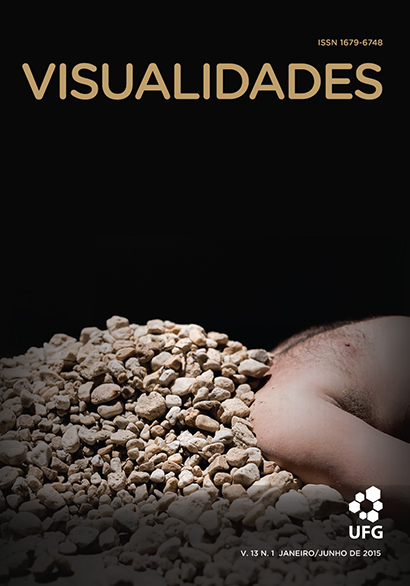Abyssalities against the grain: the clown circus without a future
DOI:
https://doi.org/10.5216/vis.v13i1.33474Abstract
By articulating Boaventura de Sousa Santos’ notion that the Western modern thinking is an abyssal thinking, we examine the functioning of such “abyssalities”, which hierarchize and turn knowledge and practices invisible, as well as operate the transmutation of old colonial domination (or colonialism) into coloniality in the visual arts system. Then we identify – as in the “coloniality of knowledge” – these same devices: the divisions in the reality of artistic production under an abyssal perspective.
Keywords: visual arts, abyssal thinking, colonialityDownloads
References
BRANDÃO, Ludmila; GUIMARÃES, Suzana. Desconstruindo o naif: a pintura de Alcides dos Santos. Revista Contrapontos, 2012.
BRANDÃO, Ludmila; PRECIOSA, Rosane. A invenção e a rua: da apropriação/reinvenção de objetos precários. Concinnitas17, ano 11, vol. 2. Dezembro de 2010, 148-159.
BOURDIEU, Pierre. A economia das trocas simbólicas. São Paulo: Perspectiva, 1999.
CASTRO-GÓMEZ, Santiago; GROSFOGUEL, Ramón (orgs). El giro decolonial: reflexiones para una diversidad epistémica más allá del capitalismo global. Bogotá: Siglo del Hombre Editores; Universidad Central, Instituto de Estudios Sociales Contemporáneos y Pontificia Universidad Javeriana, Instituto Pensar, 2007.
GROSFOGUEL, Ramon. Para descolonizar os estudos de economia política e os estudos pós-coloniais: transmodernidade, pensamento de fronteira e colonialidade global. In: SANTOS, Boaventura de Sousa. MENESES, Maria Paula (orgs). Epistemologias do Sul. São Paulo : Cortez, 2010.
______. Hay que tomarse en serio el pensamiento crítico de los colonizados en toda sua complejidade. Entrevista realizada por Luis Martínez Andrade, Metapolítica, ano 17, núm. 83, octubre - diciembre de 2013 a
______.Racismo/sexismo epistémico, universidades occidentalizadas y los cuatro genocidios/epistemicídios del largo siglo XVI. Tábula Rasa. Bogotá - Colômbia, No. 19: 31-58, julio-diciembre 2013 b.
HARAWAY, Donna. Situated Knowledges: the Science Question in Feminism and the Privilege of Partial Perspective.FeministStudies, 1988.
HESIODO. Teogonia: a origem dos deuses. 2ª ed. Estudo e tradução JaaTorrano. São Paulo: Iluminuras, 2012
QUIJANO, Aníbal. "Raza", "Etnia", "Nación", CuestionesAbiertas. In: Roland Forgues, ed. José Carlos Mariategui y Europa. La otra cara deldescubrimiento. Lima: Ed. Amauta, 1992.
KONTOPOULOS, Kyriankos.The Logic of Social Structures. Cambridge: Cambridge University Press, 1993.
MACHADO, Irene. Org. Semiótica da Cultura e Semiosfera. Organizado por Irene Machado. São Paulo: Annablume/Fapesp, 2007.
MIGNOLO, Walter D. La Idea de América Latina: La herida colonial e la opción decolonial. Barcelona: Editorial Gedise S.A., 2007.
______.The darker side of western modernity. Global Futures, Decolonial Options. Duke University Press, Durham & London, 2011.
______.Decolonial Aiesthesis and Other Options Related tho Aesthetics. Be.Bop 2012. Black Europe Body Politcs. Berlin. Alemanha, 2012.
PEREIRA, Gabriela de Gusmão. Rua dos inventos: ensaio sobre desenho vernacular. Rio de Janeiro: Ed. Francisco Alves, 2002.
SANTOS, Boaventura de Sousa; MENESES, Maria Paula (orgs.). Epistemologias do Sul. São Paulo: Cortez, 2010.
______. Para uma sociologia das ausências e uma sociologia das emergências. In: BARREIRA, César (Ed.). Sociologia e Conhecimento além das Fronteiras. Porto Alegre: Tomo Editorial, 2006.
______. Toward a New Common Sense: law, science and politics in the paradigmatic transition.Nova Iorque: Routledge, 1995.
WALLERSTEIN, Emmanuel. Capitalismo histórico y movimentos antisistémicos: Un análisis de sistemas-mundo. Barcelona: AKAL; 2004.
Sites:
ABC DE FOBIAS. Lista de fobias. Disponível em:< http://abcdefobias.blogspot.com.br/2009/02/abissofobia.html> Acesso em 24/07/2013.
ARAGUAIA, Maria. Seres da zona abissal. Disponível em:<http://www.brasilescola.com/biologia/seres-zona-abissal.htm> Acesso em 22/07/2013.
BBC BRASIL. Tiefsee. Disponível em:< http://jie.itaipu.gov.br/print_node.php?secao=turbinadas1&nid=9391> Acesso em 23/07/2013.
MIGNOLO, Walter. Estéticas Decoloniales. 2010, Disponível em:< https://www.youtube.com/watch?v=mqtqtRj5vDA> Acesso em 20/05/2013.
SPIEGEL ONLINE, 2010. Disponível em:<http://www.spiegel.de/fotostrecke/tiefsee-ausstellung-bizarre-wesen-aus-den-tiefen-der-ozeane-fotostrecke-61475-6.html>Acesso em 24/02/2014.
UNIVERSIDADE LUSÓFONA. Classificação dos Ambientes Marinhos. Disponível em: <http://oficinaexperimental.wikispaces.com/file/view/classificacao_ambientes_marinhos.pdf> Acesso em 20/07/2013.
WIKIPÉDIA, 2013. Pelagiczone. Disponível em:< http://pt.wikipedia.org/wiki/Ficheiro:Pelagiczone_pt.svg> Acesso em 24/02/2013.
Downloads
Published
How to Cite
Issue
Section
License

This work is licensed under a Creative Commons Attribution 4.0 International License .
Authors who publish in this journal agree to the following terms:
a. Authors retain the copyright and grant the journal the right of first publication, with the work simultaneously licensed under the Creative Commons Attribution 4.0 License which allows the sharing of work with acknowledgment of authorship and initial publication in this journal.
b. Authors are authorized to take additional contracts separately, for non-exclusive distribution of the version of the work published in this journal (eg publish in institutional repository or as a book chapter), with acknowledgment of authorship and initial publication in this journal.
c. Authors are allowed to publish and distribute their work online (eg in institutional repositories or on their personal page) after the initial publication in this journal, as this can generate productive changes, as well as increase the impact and citation of the published work ( See The Effect of Free Access).
Every effort has been made to identify and credit the rights holders of the published images. If you have rights to any of these images and have not been correctly identified, please contact the Visuals magazine and we will publish the correction in one of the next issues.






